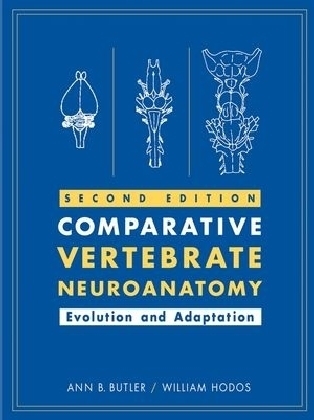
Comparative Vertebrate Neuroanatomy
Wiley-Liss Inc.,U.S. (Verlag)
978-0-471-21005-4 (ISBN)
Comparative Vertebrate Neuroanatomy
Evolution and Adaptation
Second Edition
Ann B. Butler and William Hodos
The Second Edition of this landmark text presents a broad survey of comparative vertebrate neuroanatomy at the introductory level, representing a unique contribution to the field of evolutionary neurobiology. It has been extensively revised and updated, with substantially improved figures and diagrams that are used generously throughout the text. Through analysis of the variation in brain structure and function between major groups of vertebrates, readers can gain insight into the evolutionary history of the nervous system. The text is divided into three sections:
* Introduction to evolution and variation, including a survey of cell structure, embryological development, and anatomical organization of the central nervous system; phylogeny and diversity of brain structures; and an overview of various theories of brain evolution
* Systematic, comprehensive survey of comparative neuroanatomy across all major groups of vertebrates
* Overview of vertebrate brain evolution, which integrates the complete text, highlights diversity and common themes, broadens perspective by a comparison with brain structure and evolution of invertebrate brains, and considers recent data and theories of the evolutionary origin of the brain in the earliest vertebrates, including a recently proposed model of the origin of the brain in the earliest vertebrates that has received strong support from newly discovered fossil evidence
Ample material drawn from the latest research has been integrated into the text and highlighted in special feature boxes, including recent views on homology, cranial nerve organization and evolution, the relatively large and elaborate brains of birds in correlation with their complex cognitive abilities, and the current debate on forebrain evolution across reptiles, birds, and mammals.
Comparative Vertebrate Neuroanatomy is geared to upper-level undergraduate and graduate students in neuroanatomy, but anyone interested in the anatomy of the nervous system and how it corresponds to the way that animals function in the world will find this text fascinating.
Ann B. Butler and William Hodos are the authors of Comparative Vertebrate Neuroanatomy: Evolution and Adaptation, 2nd Edition, published by Wiley.
Preface xv
Acknowledgments xix
List of Boxes xxi
Part One Evolution and the Organization of the Central Nervous System
1 Evolution and Variation 3
Introduction 3
Diversity Over Time 4
Evolutionary Mechanisms 5
Sameness and Its Biological Significance 8
Analysis of Variation 13
2 Neurons and Sensory Receptors 19
Introduction 19
The Nervous System 19
Neurons and Sensory Receptors 20
Transport Within Neurons 21
Classification of Neurons 21
Synapses 23
Neuronal Populations 26
Receptors and Senses 28
Receptor Types 30
Topographic Organization 43
Receptive Fields 46
The Senses and Evolution of the Central Nervous System 46
3 The Vertebrate Central Nervous System 49
Introduction 49
Development of the Brain 49
The Brain and Spinal Cord 61
Cellular Organization of the Central Nervous System 61
Regional Organization of the Nervous System 63
Major Systems of the Brain 67
Nomenclature of the Brain 69
4 Vertebrate Phylogeny and Diversity in Brain Organization 73
Introduction 73
Vertebrate Phylogeny 74
Two Types of Brain Organization 84
5 Evolution and Adaptation of the Brain Behavior and Intelligence 93
Phylogeny and Adaptation 93
Complexity and Evolution 96
Evolutionary Change 99
Brain Evolution and Behavioral Adaptation 100
Brain Size and Behavioral Adaptation 105
Summary and Conclusions 109
6 Theories of Brain Evolution 113
Introduction 113
Some Common Assumptions 113
Previous Theories of Vertebrate Brain Evolution: Addition of Structures or Areas 114
Previous Theories of Vertebrate Brain Organization: New Formation and Reorganization of Circuits 115
Critique of Previous Theories of Vertebrate Brain Evolution 116
Parcellation Theory 117
Current Theories of Forebrain Evolution 117
Perspective 121
Part Two The Spinal Cord and Hindbrain
7 Overview of Spinal Cord and Hindbrain 127
Overview of the Spinal Cord 127
Overview of the Hindbrain 133
Evolutionary Perspectives on the Spinal Cord and Hindbrain 136
8 The Spinal Cord 139
The Spinal Cords of Nontetrapods 139
The Organization of the Tetrapod Spinal Cord 145
Evolutionary Perspective 152
9 Segmental Organization of the Head Brain and Cranial Nerves 157
“Twelve” Cranial Nerves 157
The Vertebrate Head: Segmental Organization 158
Theoretical Head Segments 165
Segmental Organization of the Individual Cranial Nerves 166
10 Functional Organization of the Cranial Nerves 173
Introduction 173
The Cranial Nerves and the Spinal Cord 173
The Organization of Sensory and Motor Columns of the Caudal Brainstem 176
Five Cranial Nerves Rostral to the Brainstem 180
General Considerations 181
11 Sensory Cranial Nerves of the Brainstem 183
Introduction 183
Dorsal Cranial Nerves: Sensory Components for General Somatosensory Sensation 183
Ventrolateral Placodal Cranial Nerves: Taste 189
Dorsolateral Cranial Nerves: Lateral Line and Octaval Systems 194
12 Motor Cranial Nerves 205
Introduction 205
Feeding and Swallowing 207
The Acoustic Reflex 213
Motor Control of Eye Muscles 214
Evolutionary Perspective on the Hindbrain and Midbrain Cranial Nerves 218
13 The Reticular Formation 221
Introduction 221
The Organization of the Reticular Formation 222
Pathways of the Reticular Formation 230
The Reticular Formation and Sleep 234
Evolutionary Perspective on the Reticular Formation 236
14 The Cerebellum 241
Introduction 241
Overview of the Cerebellum 241
Cerebellar Size 242
The Various Forms of the Cerebellum 243
The Cerebella of Tetrapods 246
The Cerebella of Nontetrapods 246
The Cerebellar Cortex 247
The Exceptional Cerebella of Weakly Electric Fishes 259
Cerebellar Efferents and the Deep Cerebellar Nuclei 260
Evolutionary Perspective 262
Functions of the Cerebellum 262
Part Three The Midbrain
15 Overview of the Midbrain 267
Introduction 267
The Isthmus 268
The Tegmentum 273
The Tectum 273
16 Isthmus 275
Introduction 275
Nuclei of the Raphe 275
Locus Coeruleus 277
Nucleus Isthmi 281
Isthmo-Optic Nucleus 283
Midbrain Locomotor Region and Pedunculopontine Tegmental Nucleus 284
Interpeduncular Nucleus 285
17 Tegmentum and Tori 289
Introduction 289
Mesencephalic Nucleus of the Trigeminal Nerve 289
Red Nucleus and Related Nuclei 290
Substantia Nigra and Ventral Tegmental Area 292
Torus Lateralis 304
Torus Semicircularis 304
Evolutionary Perspective 277
18 Optic Tectum 311
Introduction 311
Overview of Tectal Organization 311
Overview of Tectal Connections 312
The Optic Tectum in Group I Vertebrates 315
The Optic Tectum in Group II Vertebrates 321
Evolutionary Perspective 334
Part Four The Forebrain: Diencephalon
19 Overview of the Forebrain 343
Introduction 343
Nomenclature of the Forebrain in Amniotes 344
The Diencephalon 344
The Telencephalon: Pallium 352
The Telencephalon: Subpallium 364
20 Pretectum Accessory Optic System and Migrated Posterior Tuberculum 373
Introduction 373
Pretectum 373
Accessory Optic System 389
Evolutionary Perspective 394
Migrated Posterior Tuberculum 396
Evolutionary Perspective 399
21 Epithalamus 407
Introduction 407
Epiphysis 407
Habenula 409
Evolutionary Perspective 414
22 Dorsal Thalamus 417
Introduction 417
Collothalamic Auditory System 418
Collothalamic Visual and Somatosensory Systems 426
Lemnothalamus 432
Evolutionary Perspective 437
A New Definition of the Dorsal Thalamus in Vertebrates 439
23 The Visceral Brain: The Hypothalamus and the Autonomic Nervous System 445
Introduction 445
The Hypothalamus in Anamniotes 451
The Hypothalamus in Amniotes 455
The Autonomic Nervous System 460
Evolutionary Perspective 462
Part Five The Forebrain: Telencephalon
24 Basal Telencephalon 471
Introduction 471
The Striatopallidal Complexes 472
The Striatal Amygdala 487
Cholinergic Neuronal Populations of the Basal Telencephalon 488
Evolutionary Perspective 489
25 Nonlimbic Pallium 495
Introduction 495
The Nonlimbic Pallium in Group I Vertebrates 496
The Nonlimbic Pallium in Group IIA Vertebrates 498
The Nonlimbic Pallium in Amniotes 501
Pallial Evolution and Persistent Questions of Homologies 510
26 Visual Forebrain in Amniotes 523
Introduction 523
Ipsilateral Retinal Pathways and Stereoscopic Vision 524
Visual Pathways to the Telencephalon in Mammals 524
Pathways to the Visual Telencephalon in Reptiles and Birds 537
Evolutionary Trends in the Visual System of Amniotes 540
27 Somatosensory and Motor Forebrain in Amniotes 547
Introduction 547
The Somatosensory and Motor Forebrain of Mammals 547
The Somatosensory and Motor Forebrain of Nonmammalian Amniotes 559
Evolutionary Perspective 566
28 Auditory and Vocal Forebrain in Amniotes 571
Introduction 571
Design Features of the Auditory System 574
Auditory Pathways in Tetrapods 574
Auditory Telencephalon 577
Evolutionary Perspective 589
29 Terminal Nerve and Olfactory Forebrain 593
Introduction 593
Olfactory System 593
Vomeronasal System 601
Terminal Nerve 605
Evolutionary Perspective 606
30 Limbic Telencephalon 611
Introduction 611
The Limbic Pallium in Anamniotes 612
The Limbic Pallium in Amniotes (Group IIB) 617
Limbic Subpallium: Septum 628
Evolutionary Perspective 629
Part Six Conclusion
31 Evolution of Brains: A Bilaterian View 637
Introduction 637
Invertebrate Brains and the Inversion Hypothesis 638
Brain Evolution within Chordates 644
The Origin of Vertebrates 649
The Advent of Jaws 655
Onto the Land and Into the Air 656
Theories of Vertebrate Brain Evolution 657
How Vertebrate Brains Evolve 657
Appendix: Terms Used in Neuroanatomy 665
Introduction 665
Direction and Location Terms 665
Planes of Section 666
Neuroanatomical Names 668
Derivation of Terms 668
Glossary 671
Index 679
| Erscheint lt. Verlag | 16.9.2005 |
|---|---|
| Verlagsort | New York |
| Sprache | englisch |
| Maße | 221 x 287 mm |
| Gewicht | 1973 g |
| Themenwelt | Naturwissenschaften ► Biologie ► Humanbiologie |
| Naturwissenschaften ► Biologie ► Zoologie | |
| ISBN-10 | 0-471-21005-6 / 0471210056 |
| ISBN-13 | 978-0-471-21005-4 / 9780471210054 |
| Zustand | Neuware |
| Haben Sie eine Frage zum Produkt? |
aus dem Bereich


